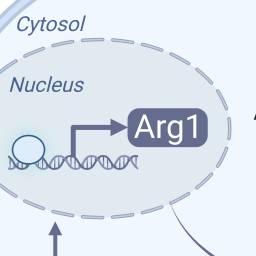A recent study published in Annals of the Rheumatic Diseases explored the effects of L-arginine metabolism on arthritis and inflammation-induced bone loss. Rheumatoid arthritis (RA) is a chronic autoimmune condition that leads to joint inflammation and bone destruction. This study investigated the role of L-arginine, a semi-essential amino acid, in modulating osteoclast activity and inflammation.

Figure 1: In inflammatory condition, TNFα promoted c-Jun expression, enhanced glycolysis and blocked oxidative phosphorylation, leading to accelerated osteoclastogenesis. In L-arginine supplementation, L-arginine inhibited c-Jun expression, restored oxidative phosphorylation and promoted ATP production. L-arginine also elevated hypoxanthine and inosine levels by reprogramming purine metabolism, which further mediate the inhibitory role of L-arginine in inflammatory osteoclastogenesis. ADA, adenosine deaminase.
In the study, L-arginine was administered to three mouse models of arthritis, including collagen-induced arthritis (CIA), serum-induced arthritis (SIA), and human TNF-transgenic (hTNFtg) mice. Results showed that L-arginine significantly reduced arthritis symptoms and prevented bone erosion across all models. Histological analysis revealed a reduction in synovitis (inflammation of joint linings) and a marked decrease in osteoclast numbers, cells responsible for bone resorption. In vitro, L-arginine was found to inhibit TNFα-induced osteoclastogenesis in both murine and human cells.
A key finding was that L-arginine switched the energy metabolism of osteoclasts from glycolysis (a process associated with inflammation) to oxidative phosphorylation, enhancing ATP production and purine metabolism. This metabolic reprogramming was crucial in reducing osteoclast formation and subsequent bone loss. The study also noted elevated levels of inosine and hypoxanthine—purine metabolites—in L-arginine-treated osteoclasts. Inhibition of these metabolites abolished the protective effects of L-arginine, emphasizing their role in its anti-arthritic action.
Further analysis of rheumatoid arthritis (RA) patients and pre-RA individuals demonstrated altered arginine metabolism, with increased arginine levels detected in patients compared to healthy controls. This suggests that arginine metabolism may be dysregulated in RA and could potentially serve as a therapeutic target.
This study underscores the therapeutic potential of L-arginine in treating inflammatory arthritis and preventing bone destruction. Its ability to reprogram osteoclast metabolism offers a novel approach to managing RA, particularly in reducing osteoclast-mediated bone loss.
Reference: Cao, Shan, et al. “L-Arginine Metabolism Inhibits Arthritis and Inflammatory Bone Loss.” Annals of the Rheumatic Diseases.
Summary by Faith Oluwamakinde










